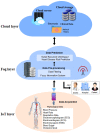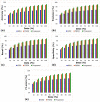Fog-Based Smart Cardiovascular Disease Prediction System Powered by Modified Gated Recurrent Unit
- PMID: 37370966
- PMCID: PMC10297507
- DOI: 10.3390/diagnostics13122071
Fog-Based Smart Cardiovascular Disease Prediction System Powered by Modified Gated Recurrent Unit
Abstract
The ongoing fast-paced technology trend has brought forth ceaseless transformation. In this regard, cloud computing has long proven to be the paramount deliverer of services such as computing power, software, networking, storage, and databases on a pay-per-use basis. The cloud is a big proponent of the internet of things (IoT), furnishing the computation and storage requisite to address internet-of-things applications. With the proliferating IoT devices triggering a continual data upsurge, the cloud-IoT interaction encounters latency, bandwidth, and connectivity restraints. The inclusion of the decentralized and distributed fog computing layer amidst the cloud and IoT layer extends the cloud's processing, storage, and networking services close to end users. This hierarchical edge-fog-cloud model distributes computation and intelligence, yielding optimal solutions while tackling constraints like massive data volume, latency, delay, and security vulnerability. The healthcare domain, warranting time-critical functionalities, can reap benefits from the cloud-fog-IoT interplay. This research paper propounded a fog-assisted smart healthcare system to diagnose heart or cardiovascular disease. It combined a fuzzy inference system (FIS) with the recurrent neural network model's variant of the gated recurrent unit (GRU) for pre-processing and predictive analytics tasks. The proposed system showcases substantially improved performance results, with classification accuracy at 99.125%. With major processing of healthcare data analytics happening at the fog layer, it is observed that the proposed work reveals optimized results concerning delays in terms of latency, response time, and jitter, compared to the cloud. Deep learning models are adept at handling sophisticated tasks, particularly predictive analytics. Time-critical healthcare applications reap benefits from deep learning's exclusive potential to furnish near-perfect results, coupled with the merits of the decentralized fog model, as revealed by the experimental results.
Keywords: Internet of Things; cardiovascular disease; cloud computing; fog computing; gated recurrent unit; healthcare; heart attack; predictive analytics; recurrent neural network.
Conflict of interest statement
The authors declare no conflict of interest.
Figures











References
-
- Guevara J.C., Torres R.D.S., da Fonseca N.L.S. On the classification of fog computing applications: A machine learning perspective. J. Netw. Comput. Appl. 2020;159:102596. doi: 10.1016/j.jnca.2020.102596. - DOI
-
- Ijaz M., Li G., Lin L., Cheikhrouhou O., Hamam H., Noor A. Integration and applications of fog computing and cloud computing based on the internet of things for provision of healthcare services at home. Electronics. 2021;10:1077. doi: 10.3390/electronics10091077. - DOI
-
- Díaz M., Martín C., Rubio B. State-of-the-art, challenges, and open issues in the integration of Internet of things and cloud computing. J. Netw. Comput. Appl. 2016;67:99–117. doi: 10.1016/j.jnca.2016.01.010. - DOI
-
- Nancy A.A., Ravindran D., Raj Vincent P.M.D., Srinivasan K., Gutierrez Reina D. IoT-cloud-based smart healthcare monitoring system for heart disease prediction via deep learning. Electronics. 2022;11:2292. doi: 10.3390/electronics11152292. - DOI
-
- Farahani B., Barzegari M., Shams Aliee F., Shaik K.A. Towards collaborative intelligent IoT eHealth: From device to fog, and cloud. Microprocess. Microsyst. 2020;72:102938. doi: 10.1016/j.micpro.2019.102938. - DOI
Grants and funding
LinkOut - more resources
Full Text Sources

